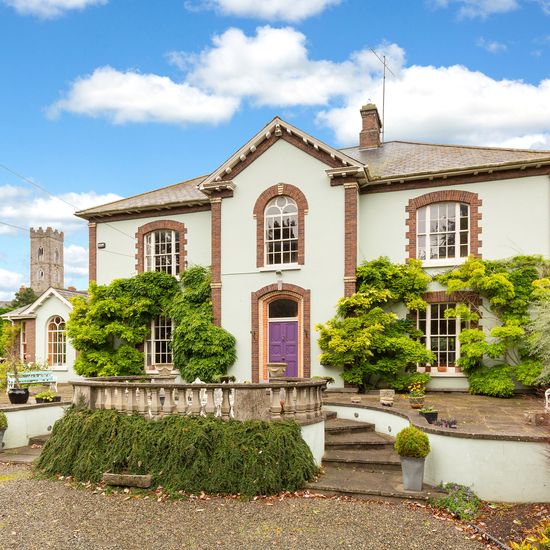By Barbara McCarthy
Copyright independent

Asking Price: €975,000
Agent: Savills (01) 6634307
The Blue School, a legend of Co Louth folk history, has just been placed for sale at a price of just under €1m.
Drogheda’s famous Blue School was set up in 1723 to educate local children and has changed buildings a number of times, with the Church Lane version being constructed around 1870 by the Cairnes local brewing family.
Students received a basic education and apprenticeship training, which would help them obtain employment in a number of skilled trades.
While many of the trades are barely known today, it is probable that the Cairnes Brewery on Marsh Road in Drogheda, which had a workforce of 200 and required trades like coopers, tunners and hoopers, benefitted from the Blue School’s trained graduates.
The Drogheda brewery was famous for its stout and Stingo Winter Ale which, as the name might suggest, was considerably stronger than the ale consumed today. The brewery was eventually sold to Guinness in 1959.
Located in the old heart of Drogheda town, the 19th-century Blue School is “hidden from plain sight” according to its current owners, Miriam and John Ryan, who say locals often don’t know the house exists.
“It’s right in the middle of the city, but you’re still surrounded by trees and church spires. The Magdalene Tower is just behind the house. You can see it when you’re sitting out on the patio,” Miriam says.
When completed in the late 19th century, the house was both a school and headmaster’s residence, and got its name after the blue uniforms worn by its pupils.
“It was built in memory of William Cairnes of Stameen by the Cairnes brewing family,” John says. “They were involved with the school board. There’s a plaque in the hallway, which commemorates their role in the town’s education.
“Our house was modelled after the Boyne Valley Hotel, which the Cairnes family used to own,” he adds.
After William Cairnes’ passing, his son Thomas invested in the construction work and commemorated the completed school as his legacy as detailed in a plaque at the site.
“A few years ago, a friend of a friend stumbled across a sign for the Cairnes from Drogheda in a little junk yard in France and brought it back to me as a fun memento,” John says.
Previous residents also included mid-Victorian artist and educator Terry Trench and his artist wife Bea Orpen, who lived at the property in the 1940s.
Orpen, who was a distant relative of celebrated Irish painter William Orpen, used it as an art studio and education centre. “There’s a painting of the house in the hallway, painted by Bea Orpen in the 1950s. The couple were quite well-known around here and they raised money for philanthropic causes.”
After the school was moved to another location in the 1980s, the building became a private residence. The Blue School’s legacy lives on today at St Peter’s National School, which inherited its traditions.
“It was divided into two flats. The previous owners then restored the building into a single home, with four bedrooms and three bathrooms across 437 sq metres.
“Until around a decade ago there were two immersions, but we converted everything into one system. Now we use the Aga in winter to heat water. In summer, we use an electric immersion which make it more affordable.
“Like all big houses, heating is an expense. The central heating comes from a gas-fired boiler. “We only turned on the Aga yesterday — once it’s warm, it heats the water beautifully,” Miriam explains.
“Before us, the Matthews family lived here. They were keen tennis players, so they would have made the most of the tennis court on the property.
“We played too, but stopped around five years ago. Once you get rid of the moss on the court, it’s ready to go. There’s even a floodlight, which could be brought back to use.”
The couple, who moved from the UK with their four children, rewired the house when they first moved in. “There was a lot to do. We installed electric gates and painted the house.
“The outside was covered in Boston ivy, so we removed that and painted it, replacing the ivy with wisteria – for a few weeks in spring it looks spectacular.”
“The kitchen was very dark and flat-roofed, so we transformed it with a cathedral-style extension, with a glass roof and timber beams. The glass and wooden beams make the kitchen much brighter,” Miriam adds.
The roof was replaced in 2003 with Spanish slate. “A lot of the modifications were carried out by Jerry Watson, a well-known local builder, who has since passed away. We also used Brian Hughes from Brady Hughes Consulting for engineering and planning to design and work on the roof among other things.”
The hallway and entrance is the centre of the house, with a sitting room, dining room, family room and study, which is also used as an office. “Upstairs we modernised and carpeted a lot of the rooms and redid the bathrooms,” he says.
In 2001, the couple added a glasshouse to the garden, which is around 0.8 acres in size.
As a heritage property and protected structure, it still has single-glazed sash windows and shutters.
“Heating can be a challenge, but that’s the trade-off for keeping the original features.”
John, who retired as a pathologist from Our Lady of Lourdes hospital in Drogheda in 2020, says he used to cycle to work from the house. “It’s so central. Just meters from William Street – the main shopping area,” he says.
With four children, it was a busy house and the space came to great use. “Our children have all flown the nest now, so we want to downsize,” Miriam says.
“Obviously it’s way too big for us now, but we had countless family gatherings: 21st birthdays, day-two wedding celebrations and lively parties,” she adds. “We’d love to see it go to a family who could enjoy it as much as we have.”
Savills seeks €975,000.



